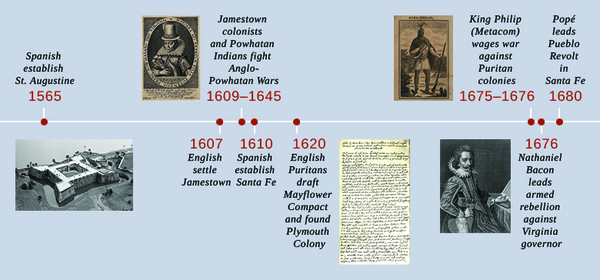| << Chapter < Page | Chapter >> Page > |

During the 1500s, Spain expanded its colonial empire to the Philippines in the Far East and to areas in the Americas that later became the United States. The Spanish dreamed of mountains of gold and silver and imagined converting thousands of eager Indians to Catholicism. In their vision of colonial society, everyone would know his or her place. Patriarchy (the rule of men over family, society, and government) shaped the Spanish colonial world. Women occupied a lower status. In all matters, the Spanish held themselves to be atop the social pyramid, with native peoples and Africans beneath them. Both Africans and native peoples, however, contested Spanish claims to dominance. Everywhere the Spanish settled, they brought devastating diseases, such as smallpox, that led to a horrific loss of life among native peoples. European diseases killed far more native inhabitants than did Spanish swords.
The world native peoples had known before the coming of the Spanish was further upset by Spanish colonial practices. The Spanish imposed the encomienda system in the areas they controlled. Under this system, authorities assigned Indian workers to mine and plantation owners with the understanding that the recipients would defend the colony and teach the workers the tenets of Christianity. In reality, the encomienda system exploited native workers. It was eventually replaced by another colonial labor system, the repartimiento , which required Indian towns to supply a pool of labor for Spanish overlords.
Spain gained a foothold in present-day Florida, viewing that area and the lands to the north as a logical extension of their Caribbean empire. In 1513, Juan Ponce de León had claimed the area around today’s St. Augustine for the Spanish crown, naming the land Pascua Florida (Feast of Flowers, or Easter) for the nearest feast day. Ponce de León was unable to establish a permanent settlement there, but by 1565, Spain was in need of an outpost to confront the French and English privateers using Florida as a base from which to attack treasure-laden Spanish ships heading from Cuba to Spain. The threat to Spanish interests took a new turn in 1562 when a group of French Protestants (Huguenots) established a small settlement they called Fort Caroline, north of St. Augustine. With the authorization of King Philip II, Spanish nobleman Pedro Menéndez led an attack on Fort Caroline, killing most of the colonists and destroying the fort. Eliminating Fort Caroline served dual purposes for the Spanish—it helped reduce the danger from French privateers and eradicated the French threat to Spain’s claim to the area. The contest over Florida illustrates how European rivalries spilled over into the Americas, especially religious conflict between Catholics and Protestants.

Notification Switch
Would you like to follow the 'U.s. history' conversation and receive update notifications?